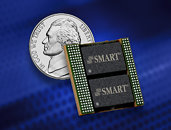Tuesday, December 10th 2013
SMART Introduces New Memory Module Form Factor
SMART Modular Technologies, Inc., a leading independent designer, manufacturer and supplier of value added subsystems including memory modules, flash memory cards and other solid state storage products, today announced MIP, the industry's first module-in-a-package memory form factor. SMART's innovative tiny form factor design is targeted for broadcast video, mobile router, high-end video/graphics cards and embedded computing applications where power consumption, performance and space limitations are of principle concern.
While SMART's MIP occupies just one-fifth the area of an SO-DIMM, it offers higher performance and consumes less power. Key improvements with MIP include 42% power savings, 42% jitter reduction, and 39% PK/PK savings. Being a "soldered down" module, unlike an SO-DIMM, the need for a mating connector is eliminated with MIP. SMART's MIP supports both, applications requiring ECC and the ones that do not. These are key benefits for applications where memory capacity in a small space is critical. And unlike other DRAM down-board usage scenarios, the MIP contains on-package address and CNTRL termination.SMART's MIP is an ideal memory solution for the emergence of new cube computing applications in networking, telecom and computing segments, as it leverages SMART's long-term, off-the-shelf stacking expertise. Offered in 2GB and 4GB densities, the MIP runs at speeds up to DDR3-2133.
"SMART has been stacking off-the-shelf DRAMs for many years providing key space-saving benefits to OEMs," stated Mike Rubino, SMART's Vice President of Engineering. "The MIP is a natural extension of this expertise furthering SMART's commitment to deliver high quality, high reliability unique memory solutions."
SMART will be showcasing its new MIP at the Embedded World 2014 Exhibition & Conference in Nuremburg, Germany at stand 4-360 starting on February 25, 2014.
While SMART's MIP occupies just one-fifth the area of an SO-DIMM, it offers higher performance and consumes less power. Key improvements with MIP include 42% power savings, 42% jitter reduction, and 39% PK/PK savings. Being a "soldered down" module, unlike an SO-DIMM, the need for a mating connector is eliminated with MIP. SMART's MIP supports both, applications requiring ECC and the ones that do not. These are key benefits for applications where memory capacity in a small space is critical. And unlike other DRAM down-board usage scenarios, the MIP contains on-package address and CNTRL termination.SMART's MIP is an ideal memory solution for the emergence of new cube computing applications in networking, telecom and computing segments, as it leverages SMART's long-term, off-the-shelf stacking expertise. Offered in 2GB and 4GB densities, the MIP runs at speeds up to DDR3-2133.
"SMART has been stacking off-the-shelf DRAMs for many years providing key space-saving benefits to OEMs," stated Mike Rubino, SMART's Vice President of Engineering. "The MIP is a natural extension of this expertise furthering SMART's commitment to deliver high quality, high reliability unique memory solutions."
SMART will be showcasing its new MIP at the Embedded World 2014 Exhibition & Conference in Nuremburg, Germany at stand 4-360 starting on February 25, 2014.

5 Comments on SMART Introduces New Memory Module Form Factor
Indeed, if don't consider the size, notebook can have better performance, unfortnately, notebook is not so small for your pocket.